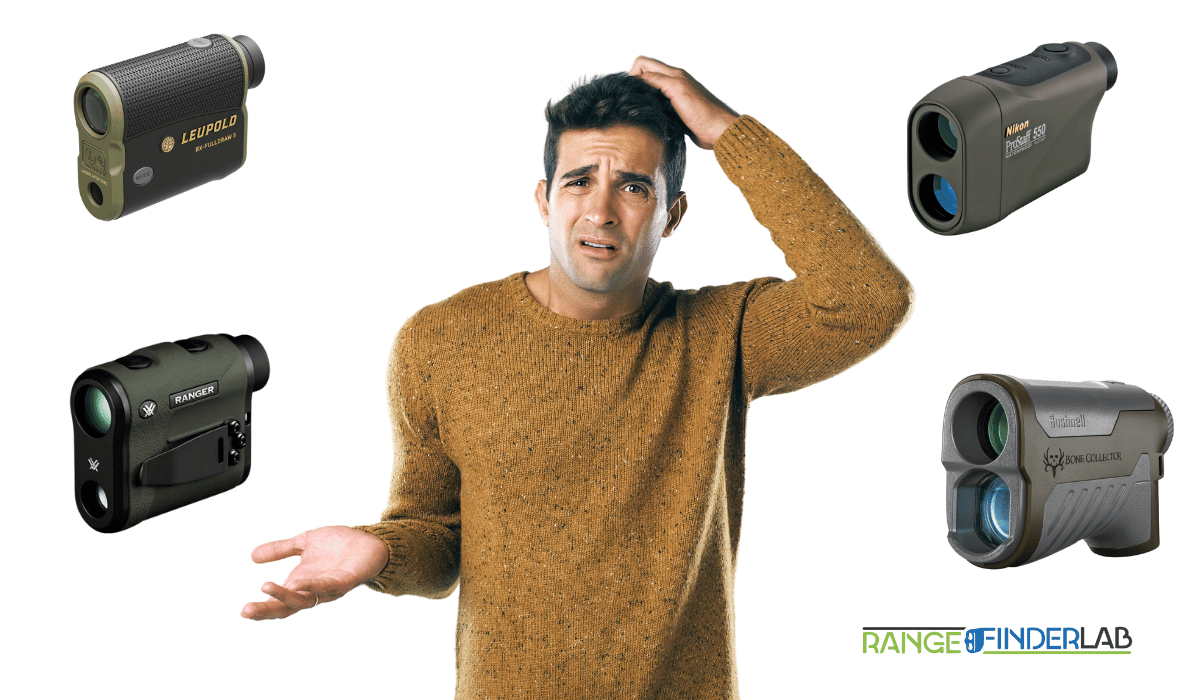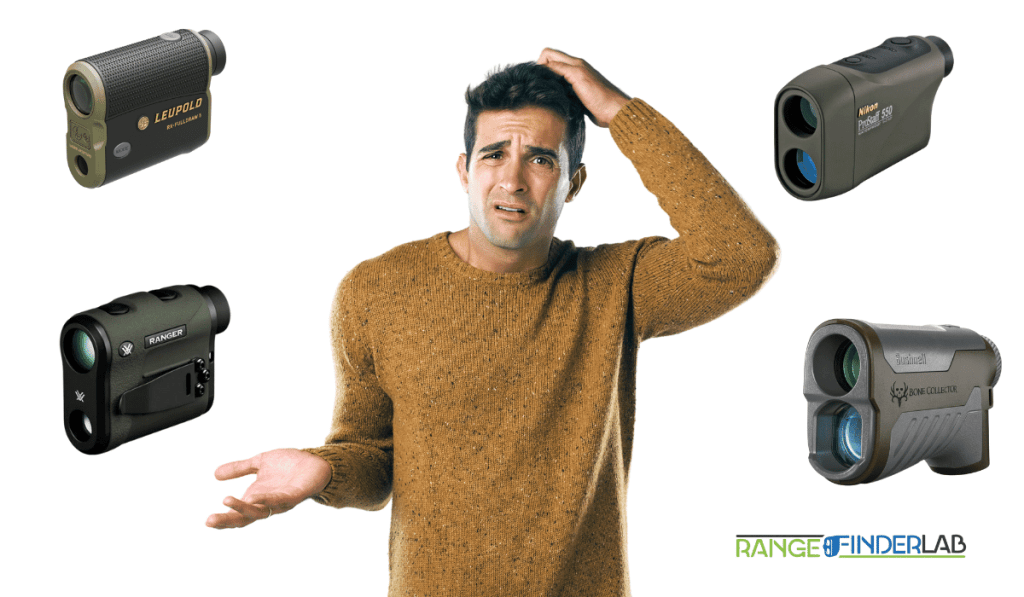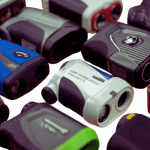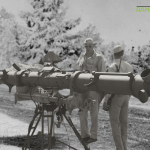

In outdoor adventures, whether hunting, golfing, or hiking, the importance of a reliable rangefinder cannot be overstated. These compact yet powerful tools have revolutionized how enthusiasts interact with their environment, offering precision, convenience, and enhancing overall experience.
At its core, a rangefinder is an instrument used to measure the distance between the observer and a target. For hunters, it means gauging the distance to their game for an accurate shot. It’s about determining the yards to the pin for the perfect swing for golfers. Even photographers and hikers find rangefinders crucial for planning landscape shots or navigating rugged terrain.
The evolution of rangefinder technology has made these tools more accessible and user-friendly, yet choosing the right one for your specific outdoor activity can be a daunting task. The market is flooded with various models, each boasting unique features and specifications. This article aims to demystify rangefinders, guiding you through selecting the perfect companion for your outdoor adventures. We’ll explore the different types of rangefinders and key features to consider and provide expert insights to make your choice more accessible and informed.
Table of contents
Understanding Rangefinders
How Rangefinders Work
Rangefinders operate on a simple yet ingenious principle. They emit a beam (laser, ultrasonic waves, or other signals) towards the target. This beam bounces back to the rangefinder, and the device calculates the time taken for this round trip. It computes the distance between the user and the target using the speed of light (for laser rangefinders) or sound (for ultrasonic models). This process, often completed in a fraction of a second, provides users with immediate and accurate distance readings.
Different Types of Rangefinders
- Laser Rangefinders: The most popular type among outdoor enthusiasts, laser rangefinders are known for their accuracy and reliability. They work best in clear conditions and can measure distances over long ranges, making them ideal for hunting, golfing, and surveying.
- Optical Rangefinders: These devices use a system of lenses and mirrors to estimate distance based on the visual overlap of images. They don’t rely on batteries or electronic components, which can be advantageous in remote areas. However, they are generally less precise than their laser counterparts and are more commonly used in historical or hobbyist contexts.
- Ultrasonic Rangefinders: Common in industrial and construction settings, these rangefinders measure distances using the echo of ultrasonic waves. They are helpful for indoor measurements, such as room dimensions, but are less effective in outdoor environments.
- GPS Rangefinders: Often used in golf, these rangefinders use GPS data to provide distance information on pre-mapped courses. They are less precise in measuring exact distances to a pin or hazard but offer valuable layout information of the entire course.
Each type of rangefinder has its unique strengths and applications. The choice largely depends on the specific requirements of the outdoor activity and the user’s preference for accuracy, ease of use, and environmental conditions.
Factors to Consider When Choosing a Rangefinder
Range and Accuracy
The primary function of a rangefinder is to measure distance, so range and accuracy are paramount. The effective range of a rangefinder can vary significantly, from a few hundred yards to several miles. For outdoor activities, a more extended range is usually more beneficial. Accuracy is equally important; look for a rangefinder that provides precise measurements, as even a tiny error can have a significant impact, especially in activities like hunting or golf.
Magnification and Optics
Magnification is a critical rangefinder feature that helps you see your target more clearly. Higher magnification provides a closer view of distant objects but can also narrow the field of view and make the device harder to stabilize. Optics quality also plays a massive role in the clarity of the image. Look for rangefinders with high-quality lenses and coatings that reduce glare and enhance light transmission.
Size, Weight, and Portability
The size and weight of a rangefinder are essential considerations for outdoor activities. A compact, lightweight rangefinder is more accessible to carry and won’t be a burden during long treks or rounds of golf. However, smaller devices might sacrifice some features or durability, so it’s about finding the right balance.
Durability and Weather Resistance
Outdoor adventures can expose rangefinders to harsh conditions. Therefore, durability and weather resistance are essential. Look for rangefinders built to withstand impacts and are either water-resistant or waterproof. This ensures your device can survive if you’re caught in the rain or if it’s accidentally dropped.
Additional Features (Slope, GPS, etc.)
Modern rangefinders come with various additional features that can be very useful. For example, a slope feature, which calculates the angle of incline/decline and adjusts the distance measurement accordingly, is invaluable for golfing. GPS functionality can provide valuable location data and maps, which are great for navigation in the wilderness. Other features like Bluetooth connectivity, ballistic data for hunting, or different target modes can also enhance the rangefinder’s utility. Consider which features align with your needs and activities.
Rangefinders for Specific Activities
Rangefinders for Hunting
For hunters, a rangefinder is a crucial tool for estimating distances accurately, which is essential for a successful and ethical shot. Hunting rangefinders typically have a more extended range and are equipped with features like angle compensation, which adjusts distance based on the angle of the shot – critical for tree stand hunters. They often come in camouflaged patterns and are more rugged to withstand outdoor elements. Some hunting rangefinders also integrate ballistic data to assist with rifle shooting.
Rangefinders for Golf
Golf rangefinders help players determine distances to the hole, hazards, and other course features, aiding in club selection and strategy. Golf-specific rangefinders usually include a slope feature that calculates the adjusted distance based on elevation change. However, this feature needs to be disabled in tournament play as per the rules of golf. These rangefinders are designed for ease of use, with quick target lock functions and clear optics. The compact size also makes them easy to carry around the course.
Rangefinders for Hiking and Bird Watching
For hiking and bird watching, rangefinders can enhance the experience by providing distance information to landmarks and wildlife. These activities typically require lightweight, easy-to-carry, and durable rangefinders. Optics quality is paramount for clear, crisp images, and a moderate range is generally sufficient. Features like GPS can be beneficial for hikers to mark waypoints or track their location. Bird watchers might prefer rangefinders with excellent close-focus capabilities to observe birds from a safe, respectful distance.
Expert Insight: Personal Opinion and Feedback
My Perspective on Selecting Rangefinders
As an expert in the field of rangefinders, I’ve learned that the key to selecting the right rangefinder lies in understanding your specific needs and the environment in which you’ll use it. My years of experience have taught me that there is no one-size-fits-all solution for rangefinders.
I always recommend a rangefinder with a durable build and advanced features like angle compensation and long-range capability for hunters. The precision in measuring distance can distinguish between a successful hunt and a missed opportunity. For golfers, a rangefinder with a slope function is invaluable, although it’s essential to have the ability to turn this feature off for tournament play. The simplicity and speed of the rangefinder are crucial in golf, where every second counts.
One common misconception is that the most expensive rangefinder is the best. While high-end models offer more features, simplicity and ease of use are sometimes more beneficial, especially for beginners. For activities like hiking or bird watching, where the focus is not just on distance but also on the enjoyment of the surroundings, a rangefinder that balances functionality with user-friendliness is ideal.
In my view, the best rangefinder is the one that fits seamlessly into your activity, enhancing your experience without complicating it. It’s about finding that perfect balance between technical capability and practical usability. As technology evolves, I am excited to see how rangefinders will continue to become more specialized and user-friendly, catering to a broader range of outdoor activities and user preferences.
Practical Tips for First-Time Buyers
Where to Start
Embarking on the journey to purchase your first rangefinder can be exciting and daunting. The key is to start by clearly identifying your primary use for the device. Are you a hunter, a golfer, a hiker, or a bird watcher? The intended use will significantly influence the type of rangefinder you need. Understand the basic features such as range, accuracy, magnification, and additional functionalities like slope measurement or ballistic data.
Budget Considerations
Rangefinders come in a wide range of prices, and setting a realistic budget is crucial. Remember, the most expensive rangefinder is not always the best for your needs. There are many high-quality, budget-friendly options available that offer excellent functionality. It’s about finding the right balance between cost and features. Don’t overlook the potential long-term costs, such as battery replacement or software updates.
Research and Reviews
Doing thorough research is vital. Read reviews from other users who have needs similar to yours. Look for unbiased reviews and comparisons to understand the pros and cons of different models. Pay attention to the user experience, ease of use, durability, and after-sales service. Additionally, visiting a store to get a hands-on feel for different models can be very beneficial. Websites, forums, and even social media groups dedicated to outdoor activities can also be excellent resources for advice and recommendations.
Maintenance and Care of Rangefinders
Maintaining the Longevity and Accuracy of Your Rangefinder
A. Cleaning and Handling
- Gentle Cleaning: Regularly clean the lenses with a soft, lint-free cloth. Avoid harsh chemicals; instead, use a mild lens cleaner.
- Protective Storage: Store your rangefinder in a case when not in use. This prevents dust accumulation and protects it from physical damage.
- Handling Care: Do not drop or jolt the rangefinder. Rough handling can misalign optics and affect accuracy.
B. Battery Management
- Regular Checks: Regularly check the battery level to ensure your rangefinder is always ready.
- Quality Batteries: Use high-quality batteries for better performance and longevity.
- Spare Batteries: Carry spare batteries during extended outdoor activities.
C. Calibration and Repair
- Routine Calibration: Follow the manufacturer’s guidelines for calibration to maintain accuracy.
- Professional Repair: If your rangefinder malfunctions seek professional repair services. Please do not attempt to disassemble it yourself.
- Firmware Updates: For rangefinders with digital features, keep the firmware updated to ensure optimal performance and access to new features.
Frequently Asked Questions (FAQs)
Addressing Common Queries About Rangefinders
- What is a good magnification for a rangefinder?
- Ideal magnification depends on the application. 6x to 8x magnification is often sufficient for hunting, providing a good balance between field of view and detail. In golf, 5x to 6x is typically adequate.
- Do you really need a slope on a rangefinder?
- Slope functionality, which calculates the angle of incline/decline and adjusts the distance reading accordingly, is beneficial in golf for better club selection. However, outdoor activities, such as primary hunting or hiking, are not essential.
- What’s the difference between a hunting rangefinder and a golf rangefinder?
- Hunting rangefinders prioritize long-range distance measurement and durability for rugged outdoor conditions. They often feature camouflage designs. Golf rangefinders focus on pinpoint accuracy for shorter distances and may include slope-adjusted distances and other golf-specific features.
- What rangefinder do I need for hunting?
- Choose a rangefinder with sufficient range (typically 600 yards or more), good magnification, and durability. Features like angle compensation, waterproofing, and a clear display are also important for hunting.
- How can I ensure accuracy with my rangefinder?
- To ensure accuracy, always hold the rangefinder steady or use a tripod for long-distance measurements. Regularly calibrate your device and clean the lenses for clear vision.
- Can rangefinders be used in all weather conditions?
- Many rangefinders are built to be weather-resistant, but it’s essential to check the specific model’s capabilities. Waterproof and fog-proof models are ideal for all-weather use.
- Are there rangefinders suitable for both golf and hunting?
- Yes, some rangefinders are versatile enough for both activities, but they may not have activity-specific features like slope adjustment for golf or extended range for hunting.
Conclusion
Embracing the World of Rangefinders
As we conclude our comprehensive exploration of rangefinders, it’s clear that these tools are more than just gadgets; they are essential companions for various outdoor adventures, whether you’re teeing off on a golf course, tracking a game in the wilderness, or simply enjoying nature’s beauty. Here’s a quick recap of the key points we’ve covered:
- Understanding Rangefinders: We’ve delved into how rangefinders work and the types available, providing insights into their functionality and versatility.
- Choosing the Right Rangefinder: We’ve discussed the crucial factors to consider, such as range, accuracy, magnification, and additional features, tailoring the choice to your specific needs.
- Activity-Specific Rangefinders: We’ve highlighted the importance of selecting a rangefinder suited to your activity, whether hunting, golf, or hiking, ensuring you get the most out of your experience.
- Expert Insight: We’ve shared personal opinions and feedback, offering a unique perspective on selecting the right rangefinder for your needs.
- Practical Buying Tips: For first-time buyers, we’ve guided starting points, budget considerations, and the value of research and reviews.
- Maintenance and Care: We’ve emphasized the importance of proper maintenance, from cleaning and handling to battery management and calibration, ensuring your rangefinder remains reliable.
Rangefinders have revolutionized how we interact with our environment, bringing precision and enjoyment to outdoor activities. Whether you’re a seasoned expert or a newcomer to the world of rangefinders, there’s always something new to learn and explore. Embrace this technology, and you’ll find that it enhances your experiences, making every adventure more fulfilling and enjoyable. Happy ranging!








